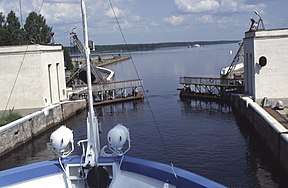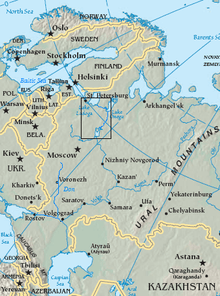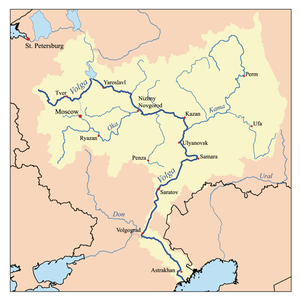Volga–Baltic Waterway
The Volga–Baltic Waterway ( Volgobalt , Волгобалт) , formerly known as the Mariinsk Canal System (Russian: Мариинская водная система), is a series of canals and rivers in Russia which link the Volga River with the Baltic Sea via the Neva River. Like the Volga–Don Canal, the Volga–Baltic Waterway connects the biggest lake on Earth, the Caspian Sea, to the World Ocean. Its overall length between Cherepovets and Lake Onega is 368 kilometres (229 mi).
| Volga–Baltic Waterway | |
|---|---|
 Volga-Baltic Waterway | |
| Specifications | |
| Length | 229[1] miles (369 km) |
| Maximum boat length | 689[2] ft 0 in (210.0 m) |
| Maximum boat beam | 57.75[3] ft 0 in (17.6 m) |
| Maximum boat draft | 4 m[4] |
| Locks | 7[5][6] |
| Status | Open |
| History | |
| Former names | Mariinsk Canal System |
| Construction began | 1960 |
| Date of first use | 5 June 1964 |
| Date completed | 1964 |
| Geography | |
| Start point | Rybinsk Reservoir, Russia |
| End point | Gulf of Finland, Neva Bay, Russia |
Originally constructed in the early 19th century, the system was rebuilt for larger vessels in the 1960s, becoming a part of the Unified Deep Water System of European Russia.
The original name "Mariinsky" is the credit to Empress Maria Feodorovna, the second wife of Emperor Paul I of Russia.[7]
History

After Peter the Great wrested the Gulf of Finland from Sweden, it was necessary to provide a secure means of river transport for Saint Petersburg on the Baltic with the Russian hinterland. The earliest Vyshny Volochyok canal system, completed by 1709, provided a connection of St. Petersburg on the Baltic to Lake Ladoga. However, the weather on Lake Ladoga frequently wrecked the barges leading to the ambitious project of the Ladoga Canals that followed the southern coast of Lake Ladoga.
Under Alexander I of Russia, the traditional waterway through Vychny Volochyok was complemented by the Tikhvin canal system (1811) and the Mariinsk canal system (1810), the latter becoming by far the most popular of the three.
The Mariinsk canal system was an outstanding monument of early 19th-century hydrotechnics, which proved to be of vital importance to the national economy. The system started in Rybinsk and passed through the Sheksna River, Lake Beloye (and Belozersky bypass canal), Kovzha River, the artificial Novomariinsky Canal, the Vytegra River to Lake Onega. Thereupon vessels sailed through the Onega Canal, the Svir River, the Ladoga Canal, and the Neva River to the Gulf of Finland.
In 1829, the Northern Dvina Canal was opened; it connects the Sheksna River (one of the Volga's tributaries) through the Kubenskoye Lake with the Northern Dvina, flowing into the White Sea. In the following decades, the system was further expanded: three more canals, Belozersky, Onezhsky, and Novoladozhsky, enabling smaller craft to bypass dangerous waters of the three big lakes (Beloye, Onega, and Ladoga), were inaugurated towards the end of the century.
Another connection was added in the 1930s, when the infamous White Sea – Baltic Canal was constructed by gulag prisoners at enormous human cost between Lake Onega and the White Sea.
In recent years, the Volga–Baltic Waterway has gained additional importance as a tourist route for boats sailing along the Golden Ring of Russia.
In 2016, the core of Belarusian nuclear power plant, VVER-1200, which was 330 tonnes, 13 meters high, and 4.5 meters in diameter, was transferred to its destination by exploiting Tsimlyansk Reservoir, the Volga-Don Canal, the Volga–Baltic Waterway, the Volkhov River and aspecial rail car.[8]
Volga–Baltic Canal improvement

In Soviet times, the Mariinsk canal system was constantly improved. Two locks were built on the Svir River (in 1936 and 1952); 3 locks were built on the Sheksna River. Major improvement of the Volga–Baltic Waterway took place in 1960–1964, and the new Volga–Baltic Waterway was opened on 5 June 1964. 39 old wooden locks were replaced with 7 new locks, and one parallel lock was built later in 1995. The locks' limiting dimensions are 210 m long, 17.6 m wide and 4.2 m deep, allowing passage of river-sea ships of up to 5000 tons displacement. Such ships were able to sail directly across the big lakes instead of using the bypass canals. Typical travel time for Cherepovets – Saint Petersburg route decreased to 2.5–3 days from 10–15 days.
The new canal route sometimes follows the route of the old Mariinsk system and sometimes diverges from it. Six of the canal's eight locks are located along 35 km of the northern slope, with a total lift of 80 metres. The only 2 locks (parallel) on the southern slope, with a lift of 13 metres are located near Sheksna on the Sheksna River, 50 km upstream from Cherepovets. The canal route on the northern slope follows the Vytegra River flooded riverbed. The summit pond of the canal between Pakhomovo locks on Vytegra River and Sheksna Reservoir dam is 278 km long. It includes an artificial divide canal (40 km long), Kovzha River, Lake Beloye, and Sheksna River. The route of the southern slope follows the Sheksna River, where it is in the backwater area of Rybinsk Reservoir.[9][10]
Current developments
The canal is actively used for oil and lumber export and as a river tourism route. According to the Maritime Board (Morskaya Kollegiya) of the Russian government, 17.6 million tons of cargo were carried over the Volga–Baltic Waterway in 2004, which is very close to the waterway's maximum capacity. The Lower Svir Lock was one of the two busiest locks on Russia's inland waterways (the other one was the Kochetov Lock on the lower Don River).[11]
See also
References
- https://bigenc.ru/geography/text/5455505
- Сроки работы шлюзов (Lock operation periods), from the site of the Russian Shipping Companies' Association. (in Russian)
- https://helpiks.org/7-23635.html
- https://helpiks.org/7-23635.html
- https://www.booksite.ru/fulltext/1/001/008/006/211.htm
- https://helpiks.org/7-23635.html
- СУДОХОДСТВО НА БЕЛОМ ОЗЕРЕ ДО И ПОСЛЕ ПРОРЫТИЯ БЕЛОЗЕРСКОГО ОБВОДНОГО КАНАЛА
- http://www.ng.ru/energy/2016-01-12/15_aes.html
- https://belsat.eu/en/news/russia-made-reactor-vessel-for-astravets-npp-arrives-in-belarus/
- http://www.ng.ru/energy/2016-01-12/15_aes.html
- Морская коллегия: Речной транспорт Archived 2008-03-07 at the Wayback Machine (Maritime Board: River Transport) (in Russian)
External links
| Wikimedia Commons has media related to Volga-Baltic Waterway. |
- Volga-Baltic waterway on Infoflot site (in Russian)
